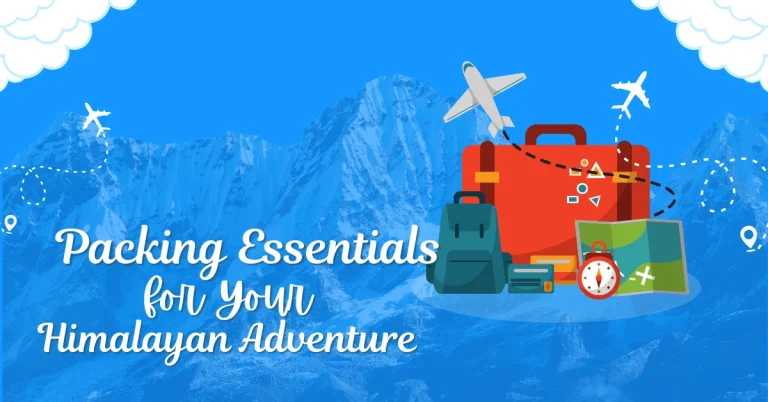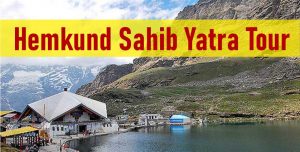What to Pack for the Himalayas — Trekking, Camping, and Sightseeing Checklist
A journey to the Himalayas is not just a vacation — it’s an adventure into the world’s most breathtaking mountain ranges. From snow-covered peaks to peaceful valleys and crisp mountain air, every moment feels surreal. But before you head out, your success depends on one critical step — smart packing.
Since the Himalayan weather is unpredictable, packing correctly can mean the difference between a comfortable and miserable trip. Whether you’re heading for trekking in Himachal Pradesh, camping in Leh-Ladakh, or sightseeing in Manali or Spiti, this guide explains exactly what to pack for your Himalayan adventure.
Whether you are going for trekking, sightseeing, or camping, read this simple guide to know what you pack for your Himalayan adventure.
1. Clothing: Dress in Layers
The key to staying comfortable in the Himalayas is layering. The climate changes quickly. The mornings can be sunny, the afternoons windy, but the nights become freezing. Instead of one thick jacket, one must wear multiple layers that you can add or remove as needed.
What to pack: Base Layer (thermal tops and bottoms to keep your body warm), Middle Layer (fleece or wool sweaters to trap heat), outer layer (a waterproof and windproof jacket to protect from rain and snow), pants (quick-dry trekking pants and one pair of warm trousers).
Tip: It is advised to avoid wearing cotton clothes as they take longer to dry. You can pack breathable, lightweight materials instead.
2. Footwear: Comfort Comes First
Your shoes will decide how easy or difficult your journey becomes. Pack good quality footwear as it will protect your feet from blisters, rough trails, and cold weather. In case you are trekking in India, it is advised to wear hiking shoes as the terrain is very slippery.
What to pack: Trekking Shoes (waterproof, high-ankle shoes), sandals or Flip-Flops, warm socks, etc.
Tip: Wear your trekking shoes for a few days before your trip to avoid shoe bites during the trek.
3. Bags and Backpacks – Packing Essentials for your Himalayan Adventure
A comfortable and sturdy backpack is one of the basic packing essentials. Choose one that fits well on your shoulders and has enough compartments. Make sure your backpack has good hip support, shoulder support, and pockets to keep things handy.
What to pack: Main Backpack (50–70 litres, to carry clothes and main gear), daypack (20–30 litres, for short hikes or carrying essentials), rain cover, etc.
Tip: Use packing cubes or zip-lock bags to organise clothes and keep them dry.
4. Sleeping Gear (For Trekkers and Campers)
If you’re going for a multi-day trek or camping in the Himachal region, you must carry your own sleeping essentials. Make sure they are comfortable.
What to pack: Sleeping Bag, sleeping mat, pillow cover or small pillow, etc.
Tip: Always air out your sleeping bag during the day to keep it fresh and dry.
5. Personal Care and Hygiene Items
Even in the wild, personal care matters. The cold weather can be harsh on your skin and body, so pack accordingly.
What to pack: Toothbrush, toothpaste, soap, and a small towel, Sunscreen (SPF 30 or above) — mountain sun can be strong, lip balm and moisturiser, hand sanitiser and wet wipes, toilet paper, etc.
Tip: Carry small travel-size bottles to save space and weight.
6. Food and Water
Food and hydration are important for energy and health. Even if food is provided by your tour or trekking team, it’s good to keep light snacks handy.
What to pack: Energy bars, dry fruits, or chocolates for instant energy, reusable water bottle or hydration pack, water purification tablets or filter bottle, instant noodles, soups, or ready-to-eat packs, etc.
Tip: Drink water regularly — dehydration can happen even in cold weather.
7. Gadgets and Essentials
A few small gadgets can make your journey smoother and more enjoyable. Items like a torch or a flashlight a very important, especially while travelling in the dark.
What to pack: Mobile phone with power bank, headlamp or flashlight with extra batteries, camera, universal plug adapter, portable charger or solar charger, earphones or small speaker, etc.
Tip: Keep gadgets in waterproof pouches or zip-lock bags to protect from moisture.
8. First-Aid Kit
In the mountains, medical help may not be available easily. A basic first-aid kit can be a lifesaver. A first aid kit is very, very necessary while trekking. The kit must include basic medicines, which may be required during the trip.
What to pack: Band-aids, antiseptic cream, cotton, pain relief spray or balm, medicines for small scissors and adhesive tape, ORS, etc.
Tip: Learn basic first-aid steps before your trip — it can be very helpful.
9. Weather & Seasonal Packing Tips for the Himalayas
Keep in mind, that the Himalayan weather can change quite drastically from one season to the next when planning your trip. What separates an excellent trip from a miserable one is packing the right gear for the right time of year. Whether you are going trekking, sightseeing, or even camping, these seasonal packing tips will help yours stay safe and enjoyable.
The packing essentials for your Himalayan adventure depend heavily on when you visit:
Summer (May to June):
Days are warm but nights can still be cold. Pack lightweight breathable clothes, UV protected sunglasses, sunscreen (SPF 50+), and a sun hat. Add a light fleece for evenings and high altitude destinations.
Monsoon (July to September):
Expect heavy rain and slippery trails. Waterproof gear is your best friend — bring a rain poncho, waterproof trekking boots and a backpack rain cover. Avoid cotton clothes; use quick dry materials that resist moisture.
Winter (October to February):
This is the coldest season in the Himalayas. Pack thermal layers, down jackets, gloves, woollen caps and insulated boots. Make sure your outer layer is windproof and snowproof to protect from freezing temperatures.
Pro Tip: Always check the local forecast before packing. A little research can help you adjust your Himalayan adventure packing list to match real-time weather conditions.
10. Altitude & Health Preparation for the Himalayas
Even the most experienced travellers can underestimate the impact of high altitude. The Himalayan region ranges between 2,000 to 5,000 metres above sea level, which can cause fatigue or mild altitude sickness if you’re not prepared. That’s why health and fitness are as important as packing essentials for your Himalayan adventure.
Key Tips for Staying Healthy in the Mountains:
- Acclimatize Gradually:
Avoid rapid ascents. If your trip involves high-altitude locations like Leh, Spiti, or Kedarnath, spend a day or two adjusting at mid-altitude destinations. - Hydration is Non-Negotiable:
The cold might mask your thirst, but dehydration is a real risk. Carry a reusable water bottle or hydration pack, and sip water every 20–30 minutes. - Eat Light but Often:
Consume energy-dense snacks like nuts, dry fruits, and protein bars. Avoid overeating or alcohol, as both can affect oxygen levels in your body. - Carry Preventive Medication:
Pack medicines for headaches, nausea, and altitude sickness (consult your doctor about Diamox). Keep a small first-aid kit handy — it’s one of the most critical Himalayan travel essentials. - Recognize Warning Signs:
Headache, dizziness, and shortness of breath are early symptoms of Acute Mountain Sickness (AMS). If you experience them, stop climbing higher and rest.
Pro Tip: The higher you go, the slower you move. Preparing your body and mind beforehand makes your Himalayan journey not just safe but also far more enjoyable.
Conclusion
Packing for the Himalayas is not just about carrying clothes. It’s about getting prepared for changing weather, rough terrain, and high altitudes. The right packing essentials for your Himalayan adventure packing helps you stay safe, warm, and light during your journey.
Whether you are heading to Manali, Shimla, Leh, Dalhousie, Spiti, or any other place in the Himalayan region, these essentials will make your Himalayan adventure more enjoyable and stress-free. So, pack smart, travel light, and get ready to experience the magic of the mighty Himalayas!
FAQs
Pack in layers. One must pack thermals, fleece, and waterproof jackets. Avoid cotton; use quick-dry fabrics that keep you warm and comfortable.
Yes. Waterproof, high-ankle trekking shoes with a strong grip are essential for walking on rocky or snowy terrain.
Yes, but carry them safely in waterproof pouches. Also, keep a power bank or solar charger, as electricity may not be available everywhere.







You must be logged in to post a comment.